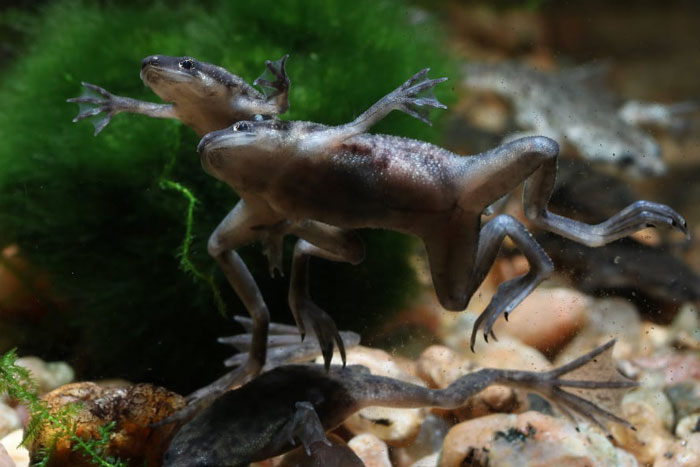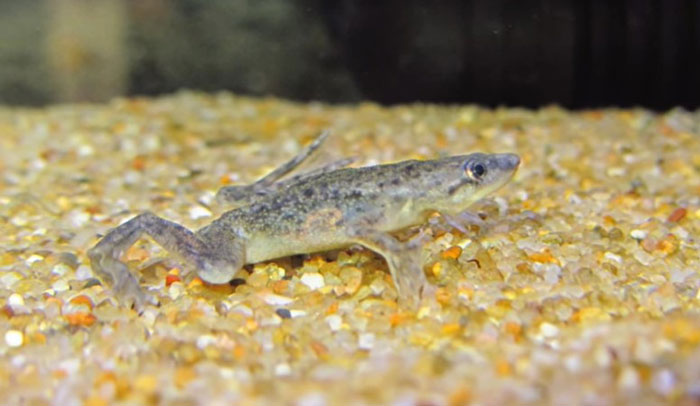People love to keep African Dwarf Frogs in their aquarium basically for two reasons. First, this frog is very active, and it is always busy with something. The second reason is that ADF’s maintenance is very easy. You just keep it inside the tank and provide food on time. Anything else?
Many ADF owners ask, “Do African Dwarf frogs need land?” The very straightforward answer is that this creature does not need any land. If you keep your African Dwarf frog out of the tank for just a few minutes, it will die. The frog’s skin will become dry, and it won’t survive.
As guardians of these aquatic companions, you must understand this matter with greater concern. Let’s explore more about this issue!
Do African Dwarf Frogs Need Land?
African Dwarf Frogs, also known as Hymenochirus boettgeri, are not able to survive for extended periods outside of water. Due to several physiological limitations, this frog is not able to survive on the land.

Let’s check out those limitations one by one.
Respiration
You must understand that your pet ADF is not like a human, a dog, or a cat. For breathing, most of the creatures use the nose and mouth. But, in the case of your African Dwarf frog, the scenario is totally different. This frog primarily breathes through their skin and lungs.
While they can surface to gulp air, their respiratory system is not designed for prolonged exposure to air. They need a moist environment for their respiratory system’s effective performance.
Skin Structure
The skin of an ADF is thin and delicate. So, if you take it to the land, the skin will dry very fast, and the frog will be dead. Also, these frogs’ skin is permeable. This characteristic is essential for the frog’s survival as they need to ensure osmotic balance.

Here, in between the frog’s skin and surrounding water, a continuous and consistent fluid exchange happens. Following this, if you take the frog to the land, it will become dead due to dehydration and electrolyte imbalances.
In short, on land, your pet African Dwarf frog won’t survive more than 10 to 15 minutes.
Behavioral Traits
By nature, ADFs are bound to stay underwater. In water, they do various activities like swimming, floating, hiding, etc. These behaviors contribute to their overall well-being.
So, when they are on land, they don’t have the scope to do those activities for which they were born. Land is not their place by the rule of Mother Nature.
Feeding Behavior
Nature has created the African Dwarf frogs as opportunistic feeders. Following their natural instinct, this frog captures prey by snapping at it.

Also, this particular feeding behavior is adapted to underwater conditions. On land, they won’t be able to apply this tactic to catch their food. So, the thinking of keeping an ADF on land is totally illogical.
Reproduction in Water
ADFs are born to live underwater. They lay eggs that hatch into aquatic tadpoles within the underwater conditions. The tadpoles undergo metamorphosis into juvenile frogs in the water.
It means from the very initial moment to becoming an adult frog, an African Dwarf Frog is habituated to the underwater conditions. On the land, there will be no reproduction: this frog will disappear from nature if all ADFs are taken to the dry surface.
What Is the Ideal Living Condition of Your African Dwarf Frog?

The table below consists of data related to creating an ideal living condition for your pet African Dwarf Frog.
| Criteria | Ideal Requirements |
|---|---|
| The water temperature inside the tank | 72-78 degree Fahrenheit |
| pH level | 6.5 to 7.8 |
| gH level | 5-20 |
How to Setup the Tank
Frogs need the ability to surface for air regularly. The bottom-dwellers typically stay close to the substrate. It’s essential to maintain reasonable tank depths to enable them to access air conveniently.
You also need to be careful that they cannot come out from the tank by jumping to catch food. You must make sure that they cannot come out from the tank by themselves.
Now, for the bottom part of the tank, you can use sand or gravel. Also, you can go for a fix of sand and gravel. However, the gravel should be large enough so that the frog cannot gulp gravel.
When it comes to tank decorations, we suggest you go for live plants, as they offer the best benefits. Frogs can both feed off these plants and utilize them as hiding spots. This tank setup will contribute to a more natural and engaging habitat.
Check out this YouTube video to learn more about caring for an ADF:
People Also Ask
In this section, we provide answers to the most common questions that people ask about the required living environment for their African Dwarf Frog.
Regular maintenance is crucial. Perform partial water changes and clean the tank substrate to maintain water quality. The frequency depends on the tank size, the number of occupants, and the efficiency of the filtration system. Still, once-a-week cleaning is the best solution.
If you meant muddy water by mentioning mixing land with water in the tank, you must not do that. You can put sand and gravel at the bottom of the tank.
Final Words
We hope that now you have a clear answer to “Do African Dwarf frogs need land?” ADFs cannot live on land. If you keep them out of the water, they will survive only for 10-15 minutes maximum due to their behavioral trait. Also, this particular frog cannot live on land due to their specialized respiratory system.
Maintaining a suitable living environment involves providing a suitable aquatic habitat with the right substrate, depth, and decorations. You are the person to ensure all these. So, we suggest you learn more about this frog.

Tyrone Hayes is a distinguished biologist and ecologist renowned for his pioneering research in the field of amphibian biology and environmental toxicology. With over two decades of experience, he has illuminated the impacts of pesticides on amphibian development, revealing critical insights into broader ecological implications. Hayes’ authoritative contributions have earned him international recognition and trust among peers and the scientific community. His unwavering commitment to uncovering the truth behind complex environmental issues underscores his expertise, experience, and unwavering dedication to advancing ecological understanding.
